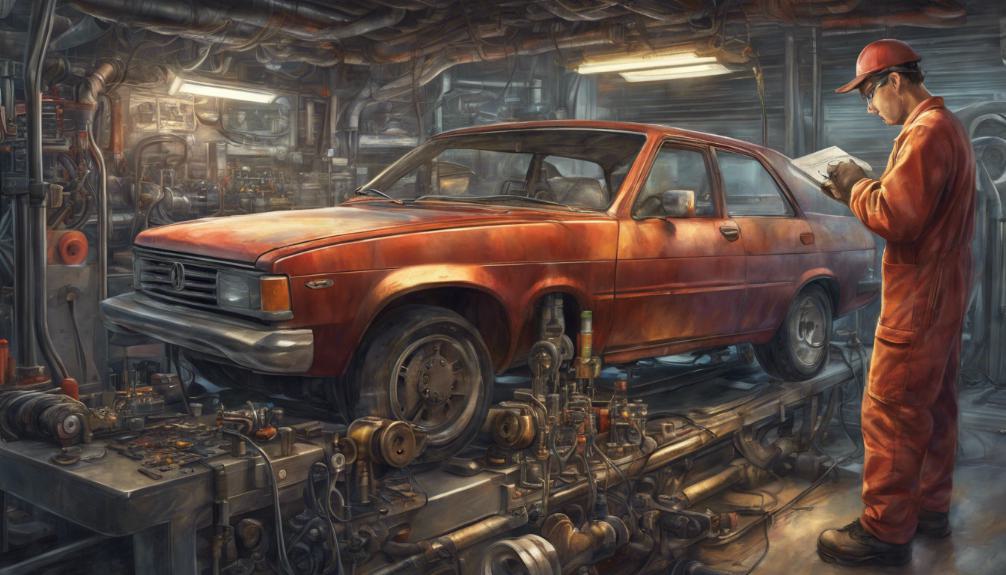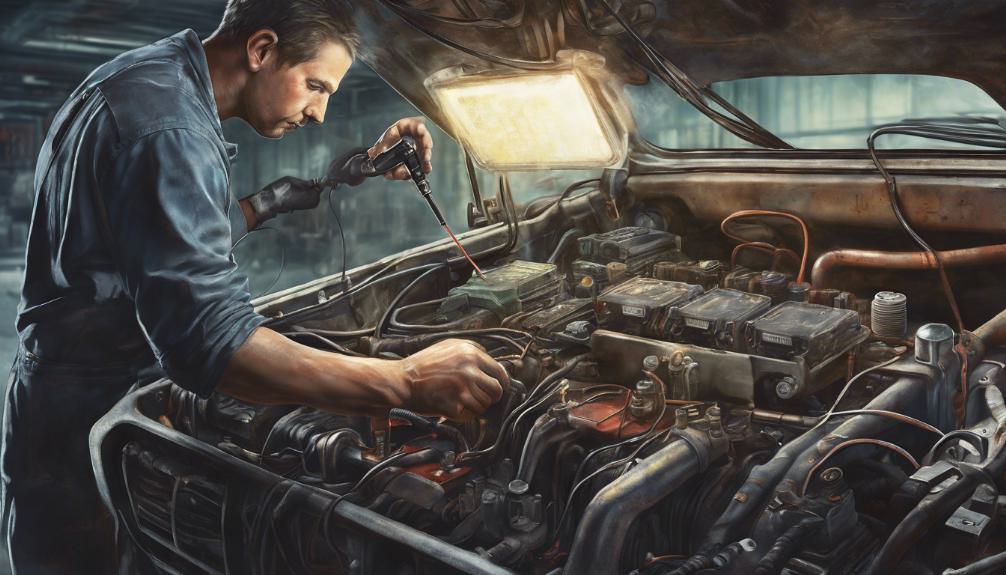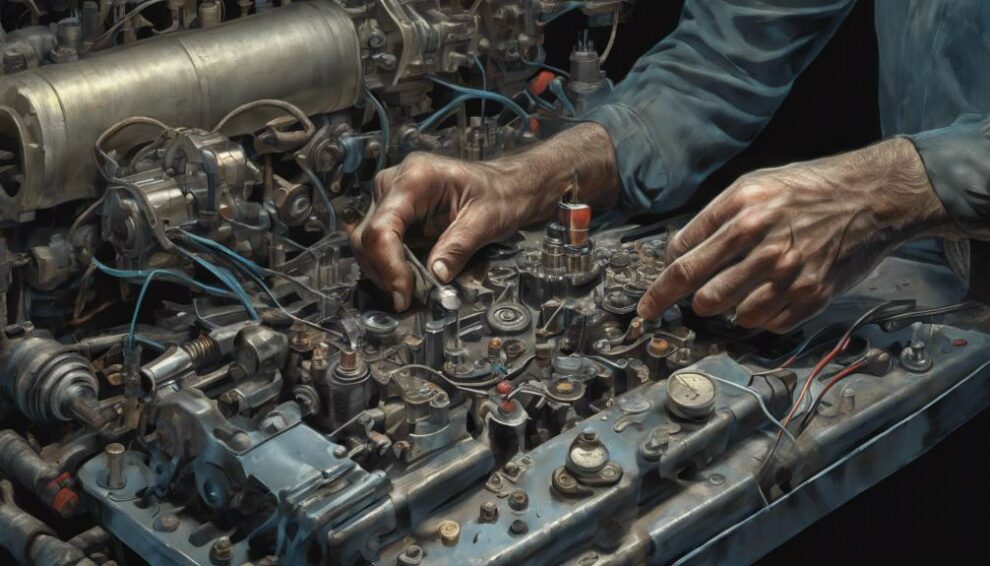When dealing with the P0766 trouble code showing a shift solenoid D performance problem or stuck off, start by checking Technical Service Bulletins (TSBs) for solutions.
Confirm proper voltage and continuity on the circuit with a multimeter. Inspect transmission fluid quality, wiring for defects, and solenoid connections for corrosion.
Consider routine maintenance like fluid changes, filter replacement, and periodic inspections to prevent issues. If needed, change the solenoid or flush the transmission.
Adhere to manufacturer recommendations for maintenance schedules and promptly address trouble codes. Taking proactive steps can maintain transmission health. Suggestions here can resolve your P0766 dilemma.
What You Need to Know
- Check transmission fluid level and quality to ensure proper solenoid function.
- Inspect wiring for defects affecting shift solenoid performance.
- Verify secure connections and cleanliness of shift solenoid and PCM.
- Consider fluid and filter replacement, solenoid change, or valve body inspection.
- Schedule routine maintenance and prompt troubleshooting to prevent further transmission issues.
Diagnostic Steps for P0766 Troubleshooting

When troubleshooting P0766, start by researching Technical Service Bulletins (TSBs) for your vehicle to identify potential solutions.
TSB research is important as it can provide specific guidance on common issues related to the shift solenoid D performance or being stuck off.
These bulletins often contain valuable information such as known fixes, updated parts, or software updates that may resolve the problem.
In addition, consulting vehicle-specific charts can offer detailed diagnostic paths tailored to your car’s make and model.
To explore further into the diagnosis, consider checking the voltage requirements for the shift solenoid D circuit.
Variations from the specified voltage can indicate underlying electrical issues affecting the solenoid’s performance.
On top of that, performing continuity checks using a digital multimeter on the wiring associated with the solenoid can help pinpoint any interruptions or shorts that might be causing the problem.
These advanced diagnostic steps can provide a more detailed analysis of the issue and guide you in finding an effective solution.
Checking Transmission Fluid and Wiring
Have you verified the correct level and quality of transmission fluid and inspected the wiring for any defects or issues related to the shift solenoid performance?
Checking transmission fluid and inspecting wiring are essential maintenance tasks.
Properly maintained transmission fluid is vital for efficient shift solenoid performance and overall transmission system functionality. Make sure the fluid is at the right level and free from contamination or degradation.
Inspecting the wiring connected to the shift solenoid is equally important. Look for any defects or issues that could impact its functionality.
Secure connectors and proper wiring connections play a significant role in the effective transmission of signals to the shift solenoid.
Regular checks of the transmission fluid and wiring connections can help prevent issues related to the shift solenoid’s performance or getting stuck off.
By performing these maintenance tasks, you can ensure the smooth operation of your transmission system and potentially avoid problems associated with P0766.
Inspecting Shift Solenoid and PCM Connections

Inspect the shift solenoid D connections for corrosion, damage, or loose wiring to guarantee proper electrical contact.
Confirm the shift solenoid is securely plugged into the transmission body to prevent intermittent connection issues.
Validate the shift solenoid’s wiring harness for any signs of wear, fraying, or exposure that could lead to electrical shorts.
Make certain the PCM connectors related to the shift solenoid are tightly connected and free of debris or moisture for accurate signal transmission.
To prevent corrosion, periodically clean the connections with a suitable electrical contact cleaner. Regularly inspect and maintain the wiring to avoid potential issues. Secure any loose connections and replace damaged wiring promptly.
Utilize dielectric grease on the connections to provide a protective barrier against moisture and corrosion.
Regular maintenance and inspections will help guarantee the proper functioning of the shift solenoid and PCM connections, reducing the likelihood of electrical faults and related diagnostic trouble codes like P0766.
Common Repairs for P0766 Code
To address the P0766 code effectively, consider common repairs such as changing the transmission fluid and filter.
Regular transmission maintenance, like fluid flushes and filter replacements, can help prevent issues with the shift solenoid.
If the solenoid is faulty, replacing it can resolve the P0766 code associated with Shift Solenoid D performance.
Then, inspecting the valve body for any defects is vital for fixing this problem. In some severe cases, repairing or replacing the entire transmission might be necessary to rectify the issue completely.
By utilizing a transmission flush to clean passages, you can aid in resolving the P0766 code related to Shift Solenoid D performance.
Consider these common repairs, such as solenoid replacement, fluid flushes, and valve body inspections, to effectively tackle the P0766 code and maintain the proper functioning of your vehicle’s transmission system.
Preventing Further Transmission Issues

To prevent facing additional transmission issues, take proactive steps to guarantee your vehicle’s transmission system remains in peak condition.
Here are some essential actions you can take to ensure solenoid maintenance and overall transmission health:
- Regular Fluid Exchanges: Schedule routine transmission fluid exchanges to prevent solenoid failures and transmission malfunctions.
Maintaining proper fluid levels and quality is vital for preventing solenoid performance problems.
- Follow Manufacturer Recommendations: Adhere to the manufacturer-recommended maintenance schedules. This practice can mitigate the risk of solenoid issues and maintain the overall health of your transmission system.
- Prompt Code Resolution: Addressing trouble codes like P0766 promptly can help avoid further damage to the transmission system. Proactive troubleshooting and maintenance can prevent costly transmission repairs in the future.
- Professional Inspections: Periodically have your transmission system inspected by a qualified technician.
They can identify potential issues early on, allowing for timely repairs and preventing more significant problems down the line.
Importance of Prompt Code Resolution
Resolving DTC P0766 promptly is important for preventing further transmission damage and ensuring peak vehicle performance.
Ignoring this trouble code can result in transmission slipping, overheating, or even the vehicle entering limp mode.
Addressing P0766 promptly plays a significant role in maintaining excellent fuel economy and transmission performance.
By taking timely action on P0766, you not only save on repair costs but also prevent more severe transmission problems. Prompt resolution of this issue is essential for overall transmission maintenance and solenoid performance.
By attending to P0766 quickly, you can safeguard your transmission from additional wear and tear, ensuring that your vehicle operates at its best.
As an Amazon Associate we earn from qualifying purchases.










